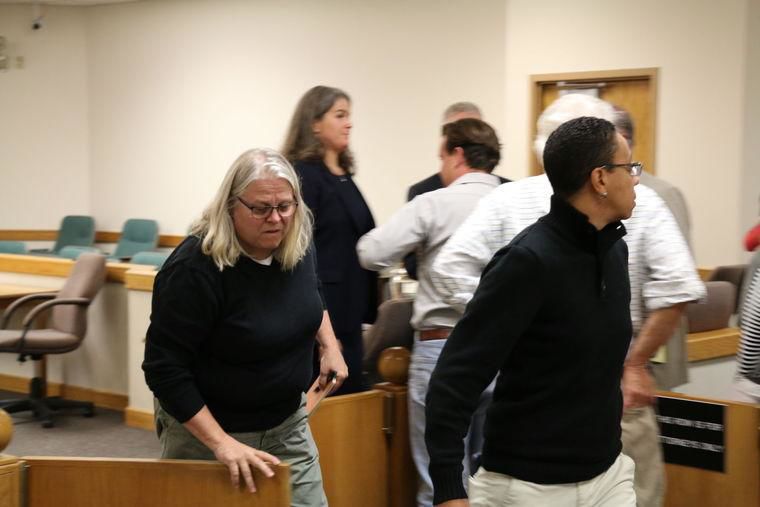Making angry, critical statements about public officials’ duties is not enough to show that there is defamation motivated by malicious intent to do actual harm, according to a federal appeals court judge.
The Utah Court of Appeals in Salt Lake City heard an oral argument on Sept. 12 in a case filed by Moab’s former city manager Rebecca Davidson and a co-plaintiff against Chris Baird, a Grand County employee, and Wyoming resident Connie McMillan and Canyon Country Zephyr publisher Jim Stiles.
Now that the oral arguments have been presented, the appeals court will make a decision in the coming months on whether the lower court’s decision in Moab still stands.
Davidson had originally filed a civil lawsuit in the 7th District Court in Moab in 2016 against the three people, all of whom she said defamed her during her tenure with the city.
At the time, Davidson’s attorney had focused on Baird’s statements referring to “financial impropriety” and “conflict of interest” in the hiring of Tayo, Inc., in which Davidson was involved.
“The worst thing that Chris Baird said — where can I find it?” Judge Lyle R. Anderson had asked during the suit’s hearing. But Davidson’s counsel, Gregory Stevens, struggled to answer the judge’s question, and in the end Anderson said that he disagreed that any of the statements in question could be considered facts.
Anderson dismissed the case on Feb. 14, 2017. Following the suit’s dismissal, a notice of appeal was filed less than a month later with the Utah Court of Appeals.
Davidson and her co-plaintiffs — Tara Smelt, her then-roommate; and Tayo, Inc., the corporation that Smelt created in June 2015 to provide emergency computer security services to the city of Moab after a consultant recommended by Davidson identified flaws in the city’s system — claimed in their complaint in the 7th District Court that the defendants’ comments were defamatory, intentionally inflicted emotional distress, and intentionally interfered with Smelt and Tayo, Inc.’s economic relationships. They sought over $5 million in damages.
In appeals court on Sept. 12 of this year, Gregory Stevens, on behalf of the plaintiffs-appellants, addressed the appellate court and said, “The real issue, or the primary issue in the case, is what the district court decided as material issues of fact. I think it’s pretty clear that in deciding that the statements made by the appellees — that deciding they were true or that they were matters of opinion — the district court judge did decide issues of fact that should be properly reserved to a jury.”
Stevens continued, “The statements that were false by Ms. McMillan include the statement — and this is probably the easiest statement the judge shouldn’t have decided as true — is that Ms. Davidson hired Ms. Smelt and Tayo, Inc., in Kemmerer, Wyoming, and gave a false reason for hiring the company to perform IT work. Continuing that statement, Ms. McMillan claimed that that repeated itself in Moab when Ms. Davidson hired Ms. Smelt and Tayo, Inc., to perform IT work for a false reason in the City of Moab.”
“Isn’t the question not whether it was actually false, but whether the defendants knew it was false, or were reckless as to whether it was false?” asked judge Diana Hagen. “And, I’m wondering what the evidence is that created a disputed fact on that being an issue. My understanding is that, by all appearances, they may have been wrong to say that she hired this company, but how would they have known that? What facts do you have that they acted recklessly as to the falsity of their statements?”
“That wasn’t an issue addressed in the district court,” Stevens said. “The district court judge simply decided that the statements were true or the judge didn’t reach the issue at all.”
A second judge in the courtroom pointed out that Anderson did address the issue.
“Fair enough,” Stevens said. “As far as Ms. Davidson, the judge decided the actors didn’t act with malice, so the evidence of actual malice is each of the defendants-appellees, Mr. Baird … showed anger.”
“It can’t be enough for actual malice simply to show that the person who made the statement is angry at how a public official is discharging their official duties,” Hagen said. “Otherwise, anyone who was incensed with how the peoples’ business was being handled would be able to show that they had actual malice — actual malice means something different than just them being upset at the way a public official handled business.”
DAVIDSON’S ATTORNEY BRINGS UP “COLD, HEARTLESS” LANGUAGE
“It is more than just being upset,” Stevens argued. “The evidence of the reason they did it is enough to present to the jury … Mr. Baird and Mr. Stiles made absolutely clear that they were not just upset, that they both referred to what Ms. Davidson did in firing two employees as ‘cold, heartless,’ and did that publicly — that’s the evidence that their motivation was valid. The question that they had malicious intent in actually making these statements I think is a question for the jury.”
The court said that Stevens had made an “inference” that there was ill-will, which led him to a conclusion that there was actual malice. But defamation suits aren’t about ill-will, the judges in the appellate court said.
Ill-will can be an indication that there was actual malice, they said, but defamation is about whether there was knowledge by the people that the statements they were making were false, the court said. Or, that the people were making false statements and did so with reckless disregard — not that they only had ill-will.
Beyond indicating that McMillan, Baird and Stiles had ill-will, the court asked Stevens what other evidence he had in the record to show that McMillan, Baird and Stiles knew their statements were false or that they knew the statements were false and acted with reckless disregard.
“I don’t think that, as far as the actual malice standard, that it requires that they knew that it was false,” Stevens answered.
The court continued to question Stevens on how anyone would know that McMillan, Baird and Stiles knew their statements were false — particularly how they would know that their comments on there being a conflict of interest were false.
“They knew that it was false,” Stevens said. “Information was given … at a city council meeting, publicly … that the relationship between Ms. Smelt and Ms. Davidson had been disclosed.”
If McMillan, Baird and Stiles had learned at the city council meeting that the potential conflict of interest had been disclosed, and then continued to make false statements and act with reckless disregard once they knew their statements were false, the court could potentially find an indicator of defamation.
But Russell Fericks, the attorney representing Baird, discussed some of the things that his client had said about Davidson, including the statements about there being a “conflict of interest” and the comments that were made at city council.
“The conflict of interest that was disclosed,” Fericks said, “was after the city decided to hire and contract with those people and get them involved in the process.”
“So you’re saying, it could still be a matter of opinion that she didn’t disclose it at the appropriate time?” Hagen said.
“Absolutely,” Fericks said.
Former city manager’s defamation suit had been dismissed in 7th District Court in 2017
“It can’t be enough for actual malice simply to show that the person who made the statement is angry at how a public official is discharging their official duties.”





